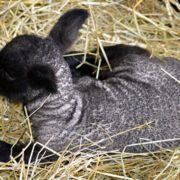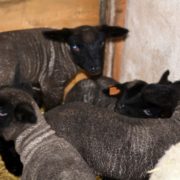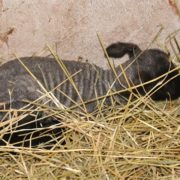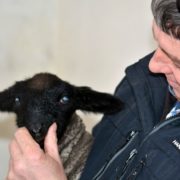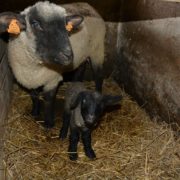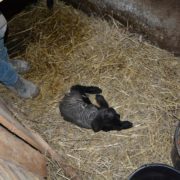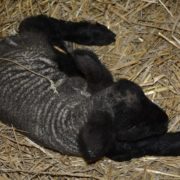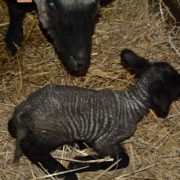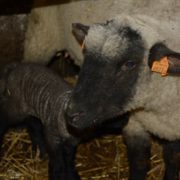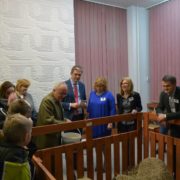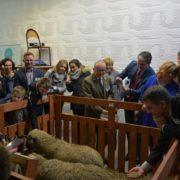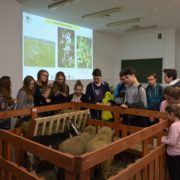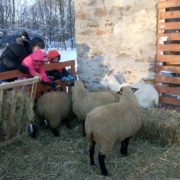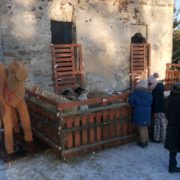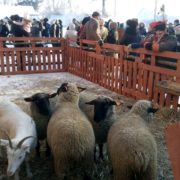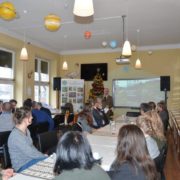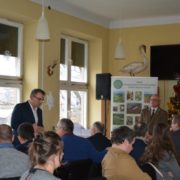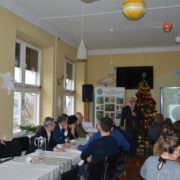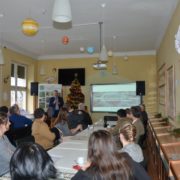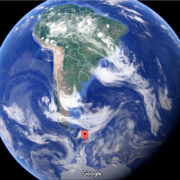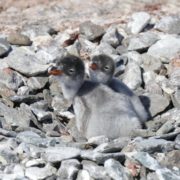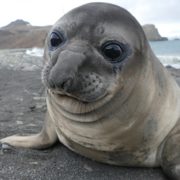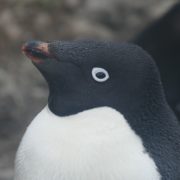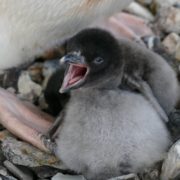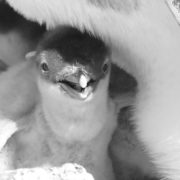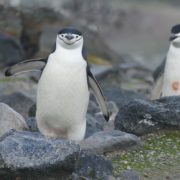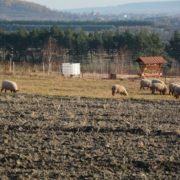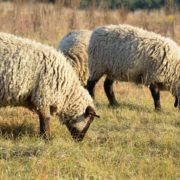Dominik
Trwają wykoty w naszych stadach.
Trwają wykoty w naszych stadach.
Według ostatniego raportu mamy już ponad 40 młodych owieczek.
Pomimo wielu propozycji wykupu jagniąt, wszyscy nasi hodowcy deklarują, że nie zamierzają pozbywać się przychówku i będą powiększać swoje stada.
Jest więc duża szansa, aby po wielu latach znów odrodziły się tradycje owczarskie na Ponidziu, tym bardziej, że otrzymujemy wiele sygnałów od rolników deklarujących chęć ukierunkowania swoich gospodarstw w kierunku owczarstwa.
To cieszy i świadczy o tym, że wysiane przez nas ziarna zaczynają przynosić plon. Wszystko z pożytkiem dla natury i oczywiście dla kieszeni rolników.
We have the first baby sheep
We have the first baby sheep in the LIFE + programme. At night, from Wednesday to Thursday, on the 23rd of February 2017, the first sheep was born at Michał Dobaj’s farm in Wola Chroberska. The first birth had been awaited long, and anxiously, by Mr Michał. As he told us, he had been on duty all night long and at 5 am, when he was exhausted and went to sleep, the little sheep decided that it was the right time. So it was born without the farmer’s assistance.
Now we are looking forward to new births on the other farms covered by the programme.
Last-minute news!!!
We have more baby sheep.
This time on Monday, 27th of February 2017, two lambs were born at Waldemar Siepracki’s farm in Stawiany in the Kije district. In the pictures, you can see the first baby sheep from Wola Chroberska with its mom.
Jest pierwsza owieczka.
Mamy pierwszy wykot w programie LIFE +.
W nocy ze środy na czwartek 23.02.2017 r. przyszła na świat pierwsza owieczka w gospodarstwie Michała Dobaja w Woli Chroberskiej.
Pierwsze narodziny były długo i z niepokojem oczekiwane przez Pana Michała.
Jak sam powiedział, dyżurował przez całą noc a gdy znużony ok. godz. 5.00 rano udał się na spoczynek właśnie wtedy owieczka zdecydowała, że to jest ten czas i samodzielnie bez pomocy gospodarza przyszła na świat.
Z niecierpliwością oczekujemy teraz na nowe narodziny w kolejnych gospodarstwach objętych programem.
Z ostatniej chwili !!!
Mamy kolejne owieczki.
Tym razem w poniedziałek 27.02.2017 r. na świat przyszły dwa baranki w gospodarstwie Waldemara Sieprackiego w Stawianach w gminie Kije.
Na zdjęciach pierwsza owieczka z Woli Chroberskiej wraz z mamą.
The Night of Biologists 2017
The Night of Biologists on Friday, January 13th, was an all-Poland event. The Jan Kochanowski University in Kielce was among the twenty one schools and universities that opened their rooms for thousands of visitors. Therefore, we also turned up there with our blackhead sheep, at the Faculty of Mathematics and Science. We set up an enclosure in one of the rooms, spread straw on the floor and filled the feeding rack with hay. Two sheep and two goats promoted the LIFE + project till late in the evening.
The living animals aroused curiosity. Although they were reluctant to be stroked, they could be fed, which was a great attraction not only for the youngest visitors. And we could inform them about how sheep contributed to the maintenance of the biodiversity of these habitats, thanks to pasturage on xerothermic grasslands and in Quercetalia pubescenti-petraeae areas. Our participation in the Night of Biologists also was an opportunity to promote sheep breeding and its benefits. We hope that in spring our flock will significantly grow. We will also visit another edition of the Night of Biologists. So see you there.
The Procession of the Three Kings in Samsonów
On the 6th of January, the sheep, which had been helping us with the LIFE+ project for almost a year, took part in the traditional Procession of the Three Kings w Samsonów. This year’s edition proceeded according to a new script, as apart from pantomime scenes performed by middle school pupils, the event also included the nativity scene, located among the picturesque ruins of a large blast furnace, which is part of the wider Old Polish Industrial Region complex.
In spite of biting frost, which the sheep endured easily, there were a lot of participants. The animals were the greatest attraction, especially for the youngest participants.
The Procession of the Three Kings was an opportunity to promote the LIFE+ project not only in the northern part of the region, but also throughout Poland, because, among one of the three processions in the whole country, it was chosen by TVP for live broadcast.
The Nativity scene in Pińczów
This year, at Christmas, in the Holy Mother Sanctuary in Pińczów, you could admire the Nativity scene located at the courtyard of the Franciscan Monastery. The place had been chosen because of St Francis, who on the 24th of December 1223, in Greccio, had organized the first Nativity scene in the world. In Poland, this tradition was initiated at the close of the 13th century by the Franciscan Order.
In Pińczów, the Nativity scene was organized for the first time. It was very popular with the inhabitants, who visited the monastery with their whole families. It was also a great opportunity to promote our project, as the blackhead sheep, which had come to Ponidzie under the LIFE13 NAT/PL/000038 project “The protection of habitats of great natural interest at the Ponidzie region”, were among the participating animals.
Pasturing flocks on xerothermic grasslands is a way to protect them, but also a tourist attraction, as sheep are very popular, especially with children.
A session of the Steering Committee
On the 15th of December, in the headquarters of the Landscape Park Complex of the Świętokrzyskie and Nadnidziańskie Region, there was a session of the Steering Committee for the LIFE13/NAT/PL/000038 project. The participants of the meeting included farmers pasturing their flocks on the grasslands covered by the project, as well as other invited guests, including Piotr Żołądek, representing the Management Board of the Świętokrzyskie Region. In a short presentation, Wojciech Sołtysiak, the project manager, showed the project progress and all the activities taken from March 2015. We also informed the Steering Committee that our activities had been approved by the European Commission, which had endorsed the interperiod report.
The essence of LIFE projects is their stability and the continuation of protective activities after the formal ending of the project. In order to make the most of the opportunities for the development and promotion of the Ponidzie region while carrying out our project, we had also invited two lecturers to the meeting. Professor Tadeusz Zając (Polish Academy of Sciences) in his lecture pointed out the natural potential of Ponidzie as well as the potential for tourism development and the possibility of earning money from natural attractions, whereas Ph.D. Andrzej Junkuszew from the University of Life Sciences in Lublin presented the economic, natural and cultural advantages of sheep breeding, and he also shared his experiences in promoting lamb’s meat coming from areas of great natural interest, which had been carried out in the Lubelskie Region.
After the official part, we had some time to talk and to taste lamb (this time not from Ponidzie yet), and, as Christmas was coming, also to give our best wishes to one another and to sing carols.
Our people in the Antarctic!
We received personal greetings, and our T-shirt advertising the protection of xerothermic grasslands travelled over 14 thousand kilometres to the place where the average annual temperature is minus 2 degrees, that is, to the Henryk Arctowski Polish Antarctic Station on King George Island at the South Shetland Islands. The participants of the 41st Antarctic expedition have been working there for six weeks. The team includes Damian Czajka, an ornithologist from the MOST Association, who worked with us on carrying out projects regarding the protection of Gliridae species and bats. Damian Czajka participates in the expedition as a paramedic, and he is also helping with the environmental monitoring to estimate of the size and condition of the population of sea birds and pennipedians. As he wrote in his email to us, “During our daily observations in the field we gather information about the location of bird nesting places, the number of nests, that is, nesting pairs, and the number of fledglings, which allows us to estimate the size of the population and their breeding success. In order to determine the condition of the birds in due time we weigh and measure eggs and fledglings. Every 10 days we monitor 9 km of the coast to estimate the number of seals and sea lions. In the breeding season, we record the number of the young animals born of these species, as well as their survival rate”.
The meteorological, glaciological and ecological monitoring conducted in the area of the Station allows them to track climate changes and transformations in the sea ecosystems. Based on this information, e.g. fishing limits are determined. At present, in the Antarctic, there are 40 all-year-round stations and 41 stations only open in summer. More information about work at the station can be found at www.arctowski.pl
When the herding?
Although the time of the customary herding already passed on the 29th of September, the sunny weather allowed our sheep to go to work again to their Ponidzie pastures. The chances are that the pasture this year would be exceptionally long to the breeders’ delight, and to the satisfaction of the LIFE + team. In the ending season, our blackhead sheep have done a lot of protective work, the first effects of which would certainly be visible in the following year.
In the photos by Włodek Rudolf, you can see sheep from Grzegorz Szymański’s farm on the hills at Skowronno near Pińczów.
Kiedy redyk?
Pomimo, że czas zwyczajowego redyku już minął 29 września, to słoneczna aura sprawiła, że nasze owce znów wyszły do pracy na ponidziańskie „hale”. Wszystko wskazuje na to, że tegoroczny wypas będzie wyjątkowo długi ku uciesze hodowców i zadowoleniu załogi LIFE +. W kończącym się sezonie, nasze czarnogłówki wykonały ogromną pracę ochronną której pierwsze efekty z pewnością będą widoczne już w przyszłym roku.
Na zdjęciach Włodka Rudolfa owce z gospodarstwa Grzegorza Szymańskiego na wzgórzach pod Skowronnem koło Pińczowa.













